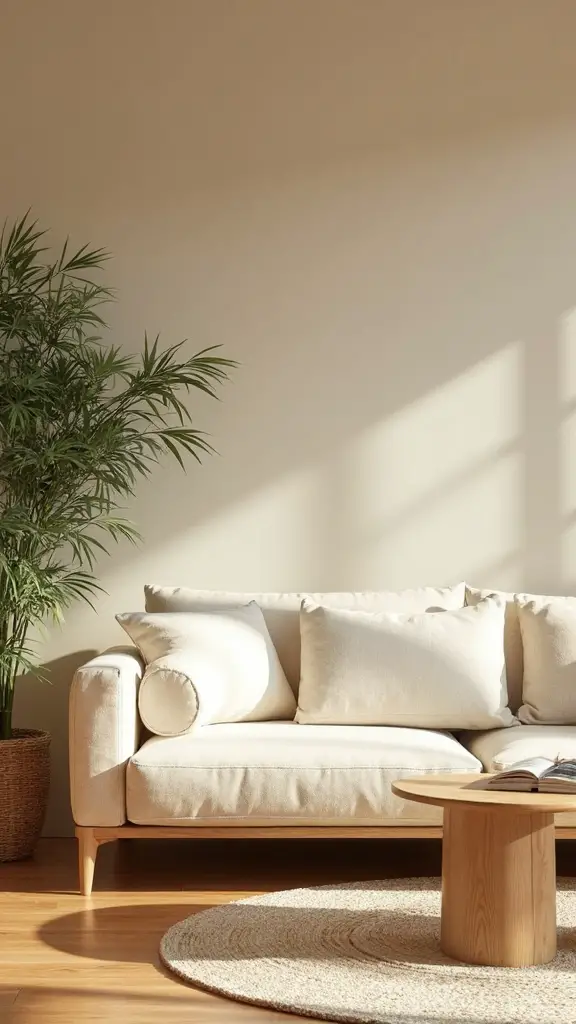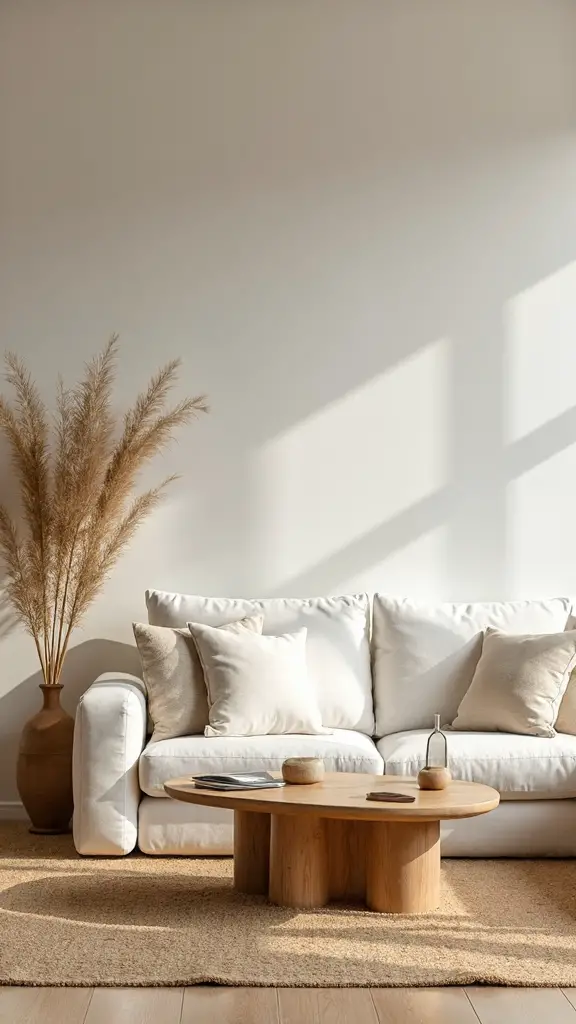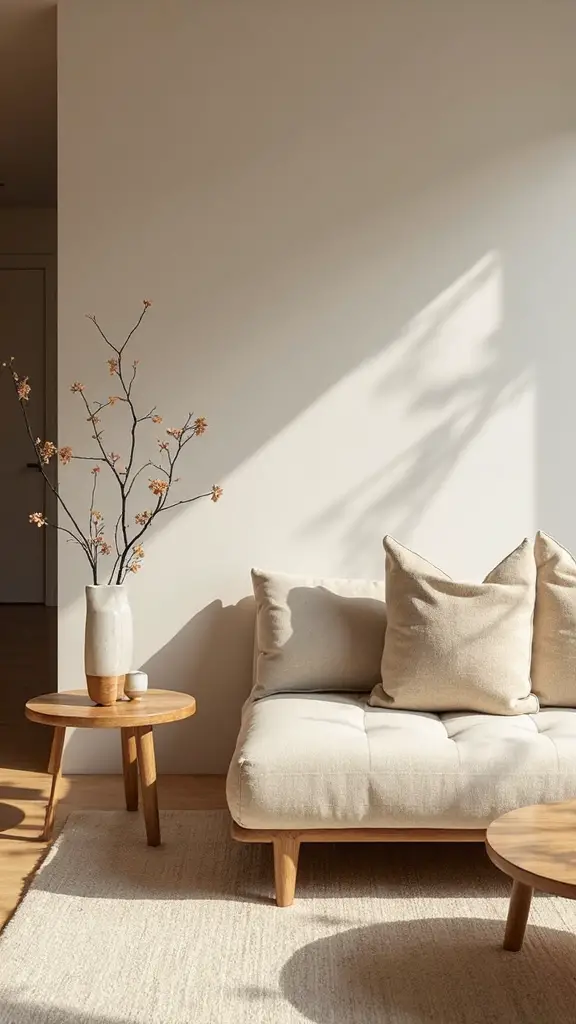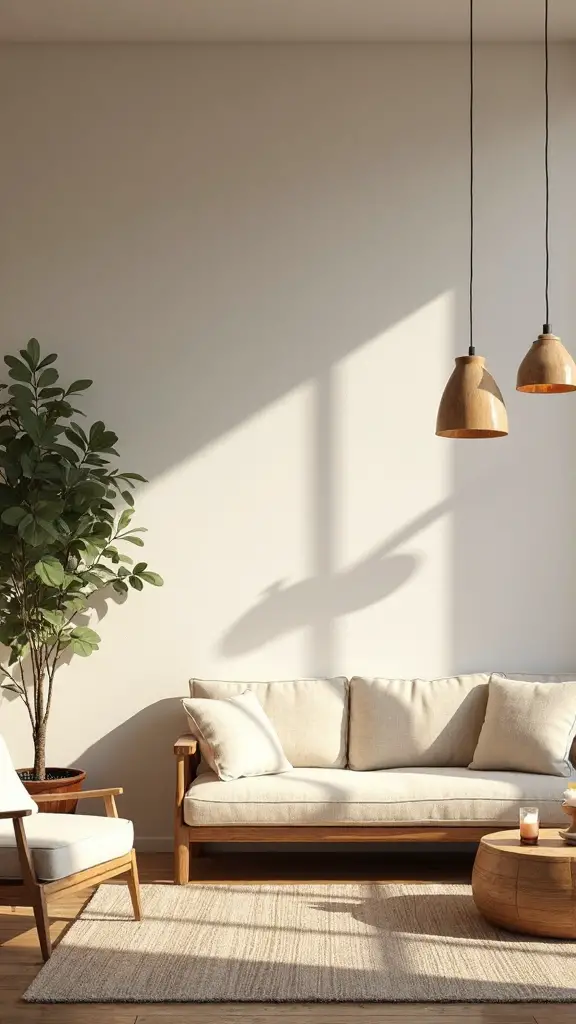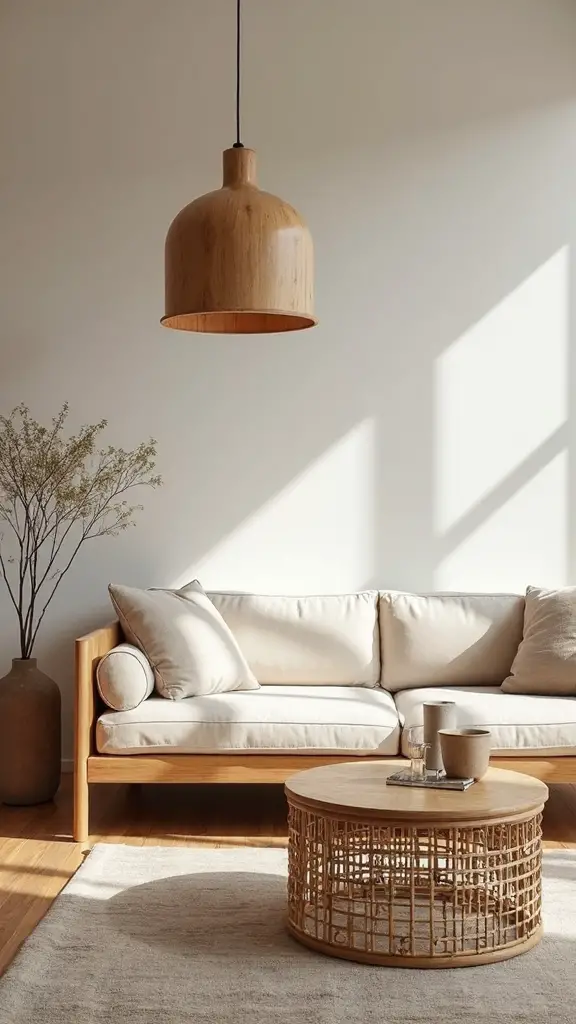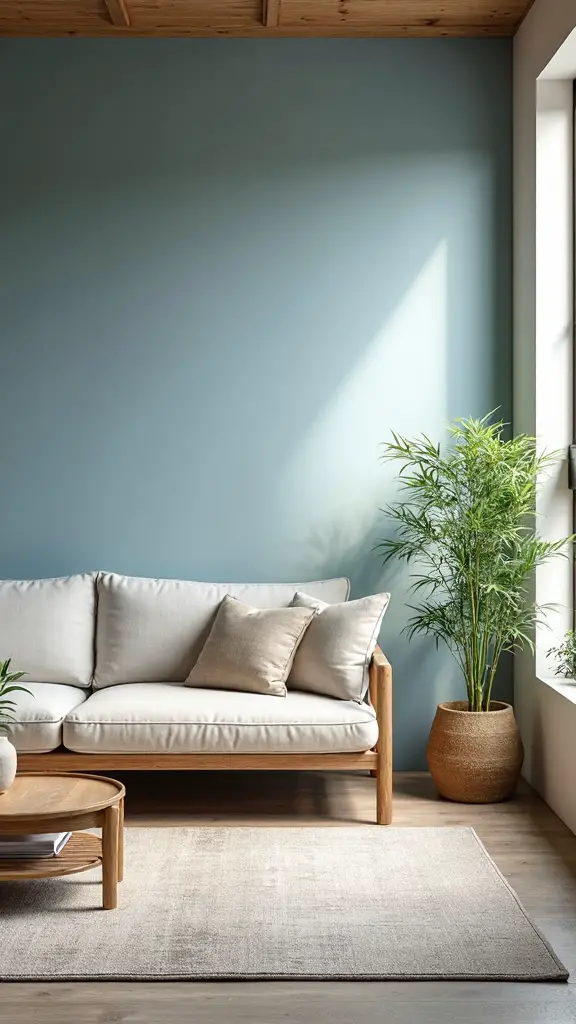20 Sleek Japandi Apartment Living Room Ideas Perfect for Minimalist Homes
Create a serene minimalist sanctuary with these 20 stunning Japandi living room ideas that perfectly blend Japanese zen with Scandinavian warmth.
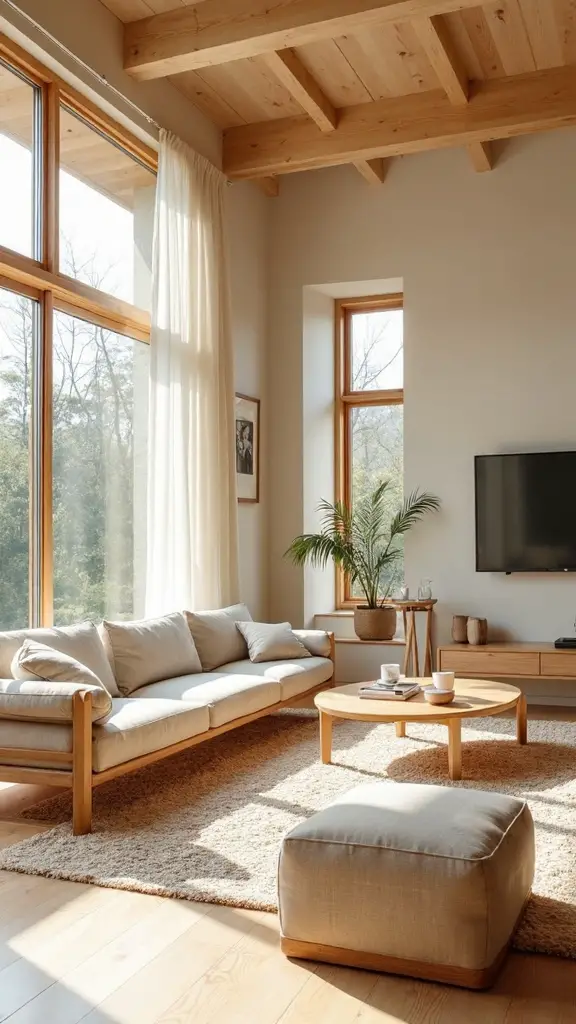
You’ll uncover that creating a stunning Japandi living room isn’t about following strict rules—it’s about finding balance between Japanese minimalism and Scandinavian coziness. This harmonious design approach alters your apartment into a peaceful retreat where every element serves a purpose. From selecting the perfect neutral palette to positioning low-profile furniture that doesn’t overwhelm your space, these twenty carefully curated ideas will help you achieve that effortlessly sophisticated look that’s enthralling homeowners worldwide.
Create a Serene Foundation With Neutral Color Palettes
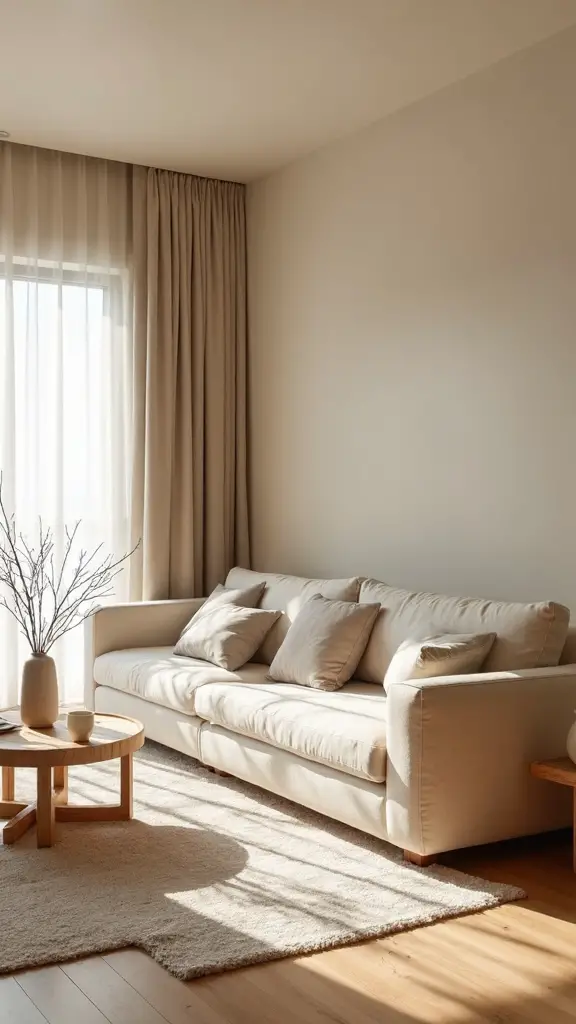
When converting your apartment living room into a Japandi sanctuary, neutral color palettes serve as the cornerstone that sets the entire mood and atmosphere. You’ll want to stick with whites, creams, beiges, and grays to establish your minimalist foundation. These calming hues create the perfect backdrop for incorporating natural wood tones through furniture and accent pieces, adding essential warmth to your space.
Light-colored walls and window treatments will maximize natural light, making your room feel more spacious. Add subtle earthy colors like sage green through textiles or artwork to create visual interest while maintaining that serene ambiance.
Incorporate Low-Profile Furniture for Modern Minimalism
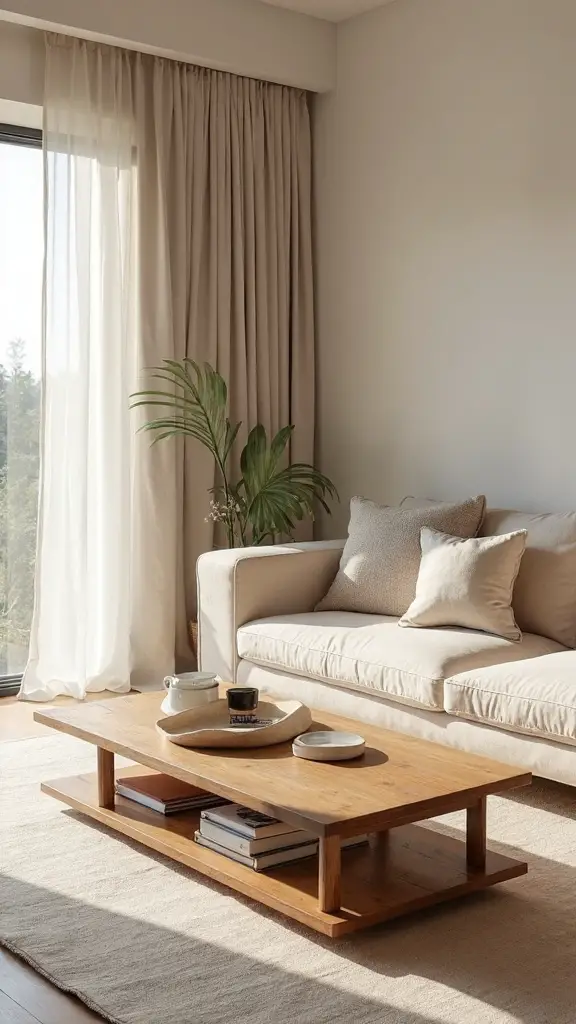
Building on your serene neutral foundation, low-profile furniture becomes your next powerful tool for achieving authentic Japandi minimalism in your apartment living room. Choose sofas, armchairs, and coffee tables with clean lines and minimalist silhouettes that sit close to the floor. Select pieces crafted from natural materials like wood or rattan to maintain authenticity.
Incorporate multi-functional pieces such as modular sectionals or storage ottomans that maximize your apartment’s limited space. Add a low-profile TV stand that seamlessly integrates with your design. Complete the look with floor lamps and side tables that maintain an unobtrusive appearance throughout your space.
Layer Natural Wood Tones Throughout Your Space
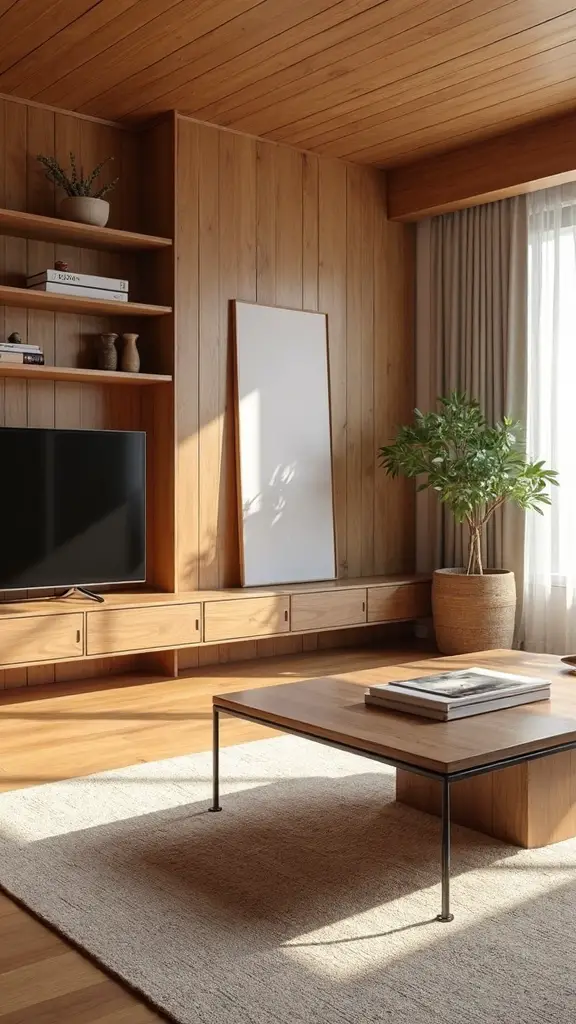
As you move from selecting low-profile furniture pieces, natural wood becomes the essential element that brings warmth and authentic Japanese-Scandinavian character to your apartment living room. Create depth by combining oak’s golden hues with walnut’s rich darkness throughout your space.
Position a solid wood coffee table as your focal point, then echo these natural materials through side tables and media consoles. Light-toned hardwood flooring provides the perfect foundation for minimalist living while supporting Scandinavian functionality.
Layer wooden artwork frames, trays, and decorative objects to enhance Japanese elements. This strategic mixing of wood tones prevents monotony while maintaining sophisticated layered lighting opportunities.
Maximize Natural Light With Strategic Window Treatments
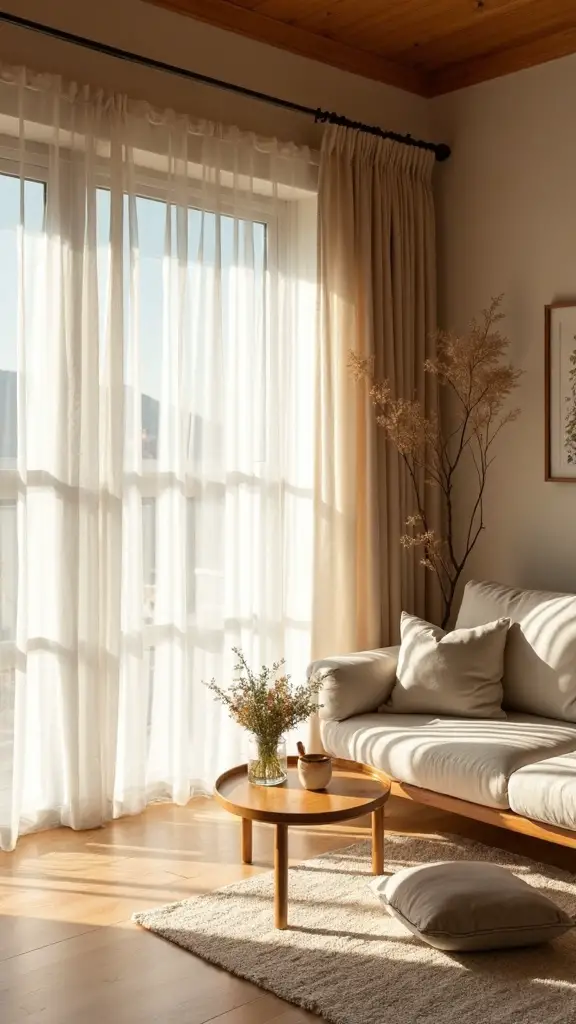
Natural light metamorphosizes your carefully curated wood elements into a glowing showcase that embodies the bright, airy essence of Japandi design. Choose sheer curtains over heavy drapery to filter sunlight while maintaining privacy and reducing visual clutter.
Large windows become focal points when you position seating strategically nearby, creating natural gathering spots. Install floor-to-ceiling treatments to maximize natural light flow throughout your space.
Balance light and dark elements by incorporating mirrors opposite windows to amplify illumination. Consider your room’s orientation when selecting window treatments—east-facing spaces benefit from light-filtering options during morning hours, while west-facing rooms need adjustable coverage for afternoon sun.
Add Warmth Through Textured Natural Materials
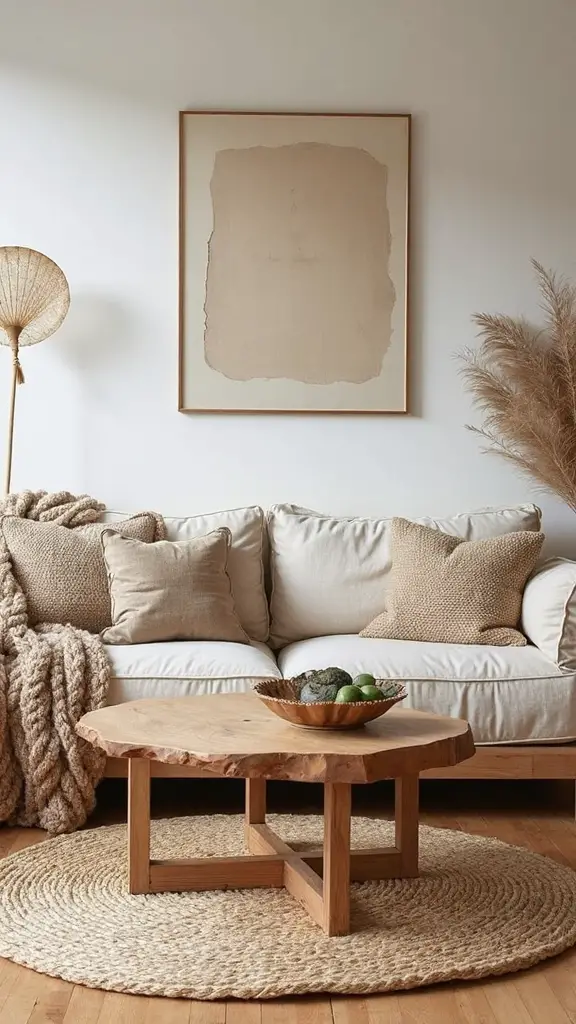
While minimalist aesthetics form Japandi’s foundation, carefully selected textured materials vary sterile spaces into inviting sanctuaries that summon you to touch and investigate.
Choose furniture showcasing exposed wood grain or matte finishes that celebrate natural materials’ inherent beauty. Incorporate rattan accents through side tables or pendant lighting for visual warmth. Layer textures using area rugs, throw pillows, and blankets crafted from natural fibers like wool, jute, or linen. Display handcrafted ceramics and woven textiles to add artisanal charm. Complete your design with organic elements including woven baskets and potted plants that strengthen your living room’s connection to nature.
Design With Functional Storage Solutions in Mind
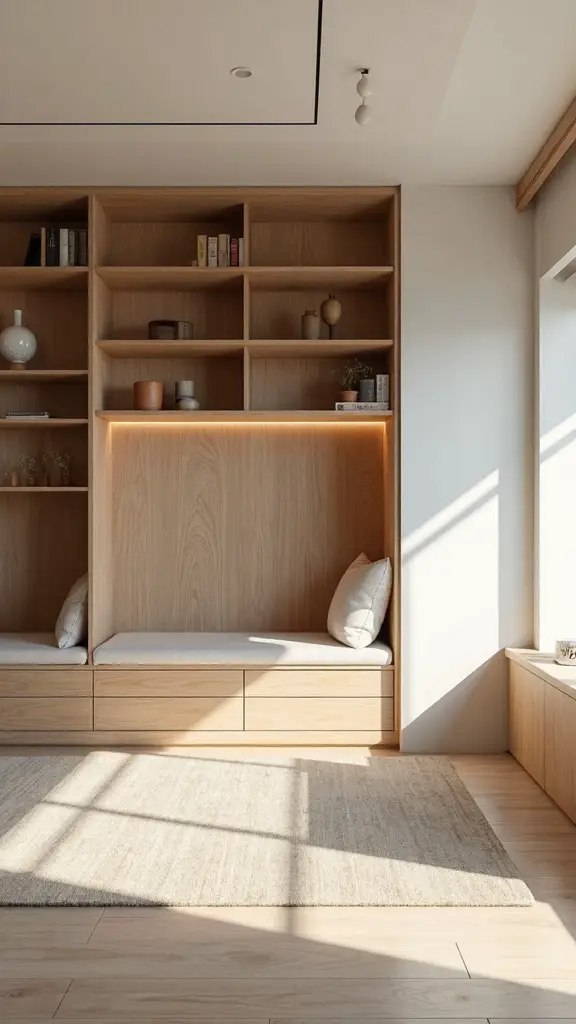
Beautiful textures create the foundation, but smart storage solutions alter your Japandi living room into a truly functional space that maintains its serene aesthetic. Choose streamlined furniture like coffee tables with hidden compartments and ottomans featuring internal storage to organize essentials without visual clutter.
Built-in shelving and floating shelves maximize your minimalist homes’ potential while preserving that airy feeling. Multi-purpose furniture becomes essential—invest in modular sofas with storage compartments for blankets and remotes.
Your living room design benefits from versatile TV consoles that blend seamlessly with Japandi furniture, providing functional storage solutions for media components and decorative accents.
Embrace Wabi-Sabi Philosophy in Your Decor Choices
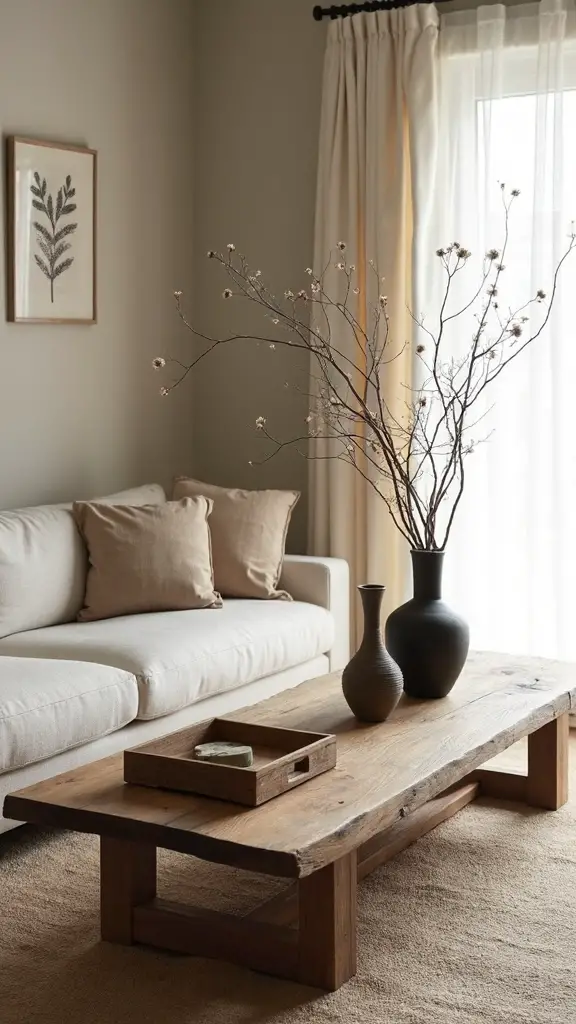
Finding beauty in imperfection alters your Japandi living room from merely functional to deeply meaningful through the ancient philosophy of wabi-sabi. You’ll uncover character by selecting chipped ceramics, weathered wood pieces, and handmade crafts that showcase slight variations and asymmetry.
Choose organic furniture shapes with natural textures that reveal their authentic aging process rather than hiding wear patterns. This mindful and appreciative approach remodels your space into something genuinely personal.
Adopt decor items with subtle flaws and handcrafted elements that contribute to your room’s understated aesthetic while celebrating the honest beauty found within imperfection itself.
Create Ambient Lighting With Paper and Bamboo Fixtures
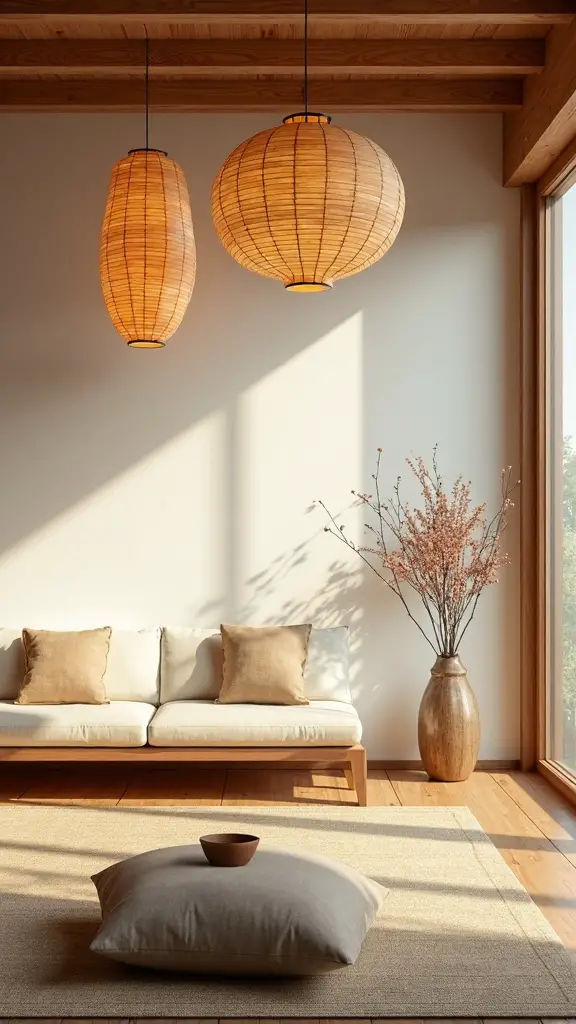
Lighting becomes the soul of your Japandi living room when you introduce paper and bamboo fixtures that cast gentle, warm illumination throughout the space. Choose minimalist cylindrical paper pendant lights or woven bamboo pendant fixtures to create soft, diffused lighting that complements your natural materials.
Position delicate paper pendants in clusters above seating areas for functional ambient lighting. Add bamboo floor lamps with linen shades to layer your illumination while introducing organic textures. Install dimmable lighting controls to adjust brightness levels, creating the perfect cozy atmosphere for your serene Japandi sanctuary.
Integrate Indoor Plants for Organic Beauty
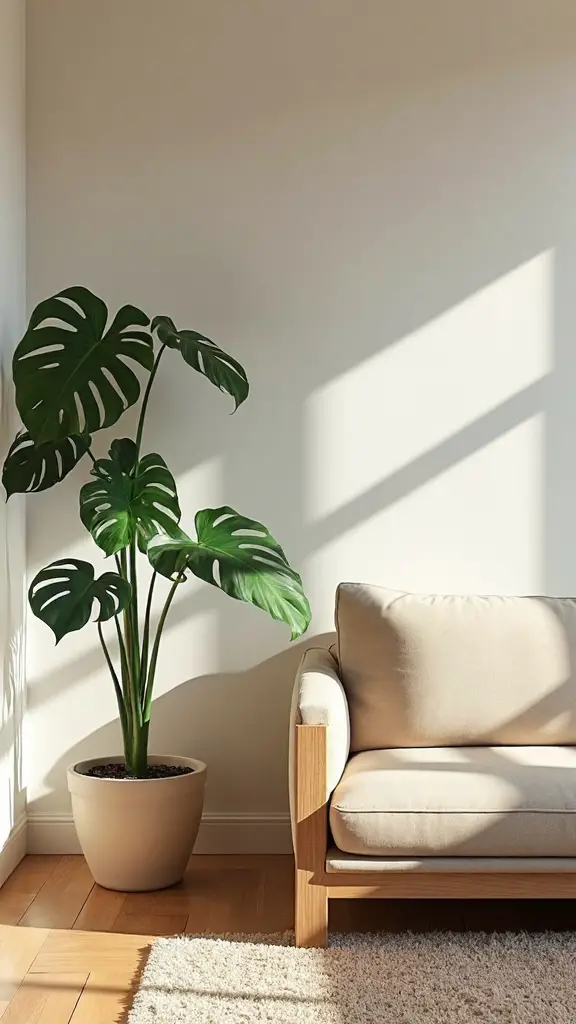
When you introduce carefully selected plants into your Japandi living room, you’ll convert the sterile minimalism into a breathing, organic sanctuary that celebrates nature’s quiet beauty. Position lush monstera deliciosa or fiddle-leaf figs strategically to frame structural features while maintaining the clean aesthetic.
Choose low-maintenance succulents in simple ceramic planters that reflect natural materials central to both Japanese and Scandinavian design philosophies. Create vertical interest with trailing vines on shelves or plant stands that enhance openness.
Balance larger statement plants with smaller potted greenery throughout your natural design, ensuring your Japandi living rooms feel harmoniously connected to nature.
Choose Quality Handcrafted Furniture Pieces
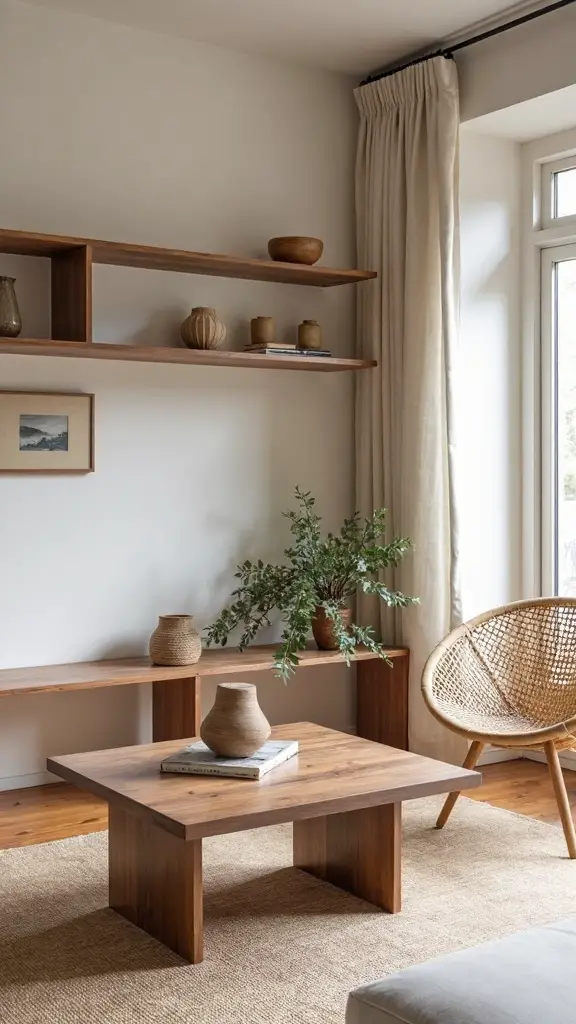
Every exceptional Japandi living room begins with carefully selected furniture pieces that showcase superior craftsmanship and natural material beauty. Invest in quality pieces made from solid wood, leather, and natural fibers that’ll enhance your space’s aesthetic.
Look for minimalist, clean-lined sofas and coffee tables that highlight their construction materials. Incorporate statement pieces like handmade ceramic vases or sculptural wooden side tables to add visual interest while maintaining simplicity.
Choose multi-functional furniture such as storage ottomans to keep your living room clutter-free. Select pieces with straightforward silhouettes that blend seamlessly with neutral palettes and natural materials.
Design an Open Floor Plan for Better Flow
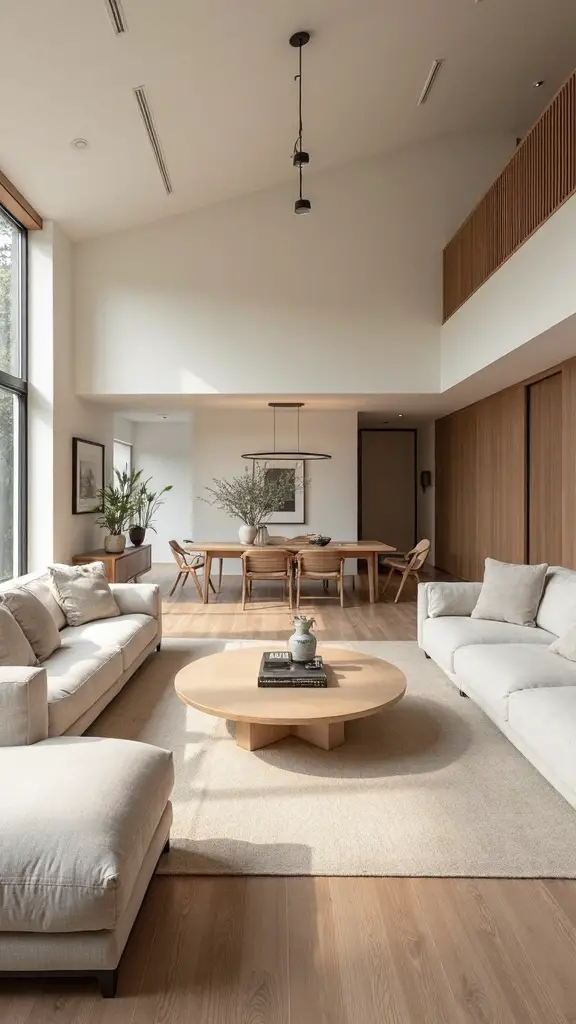
Open floor plans serve as the foundation for authentic Japandi design, creating effortless shifts that enhance your apartment’s natural flow and spacious feel. Remove unnecessary walls or choose low-profile furniture to establish an uncluttered, cohesive environment that embodies minimalist principles.
Strategic furniture placement defines distinct zones while maintaining visual continuity throughout your space. Position seating areas and functional elements to create natural pathways that guide movement seamlessly.
Maximize natural light by incorporating large windows or sliding doors, amplifying your room’s airy atmosphere. This seamless passage between indoor and outdoor spaces reinforces the balance and harmony essential to successful Japandi interiors.
Add Depth With Layered Rugs and Textiles
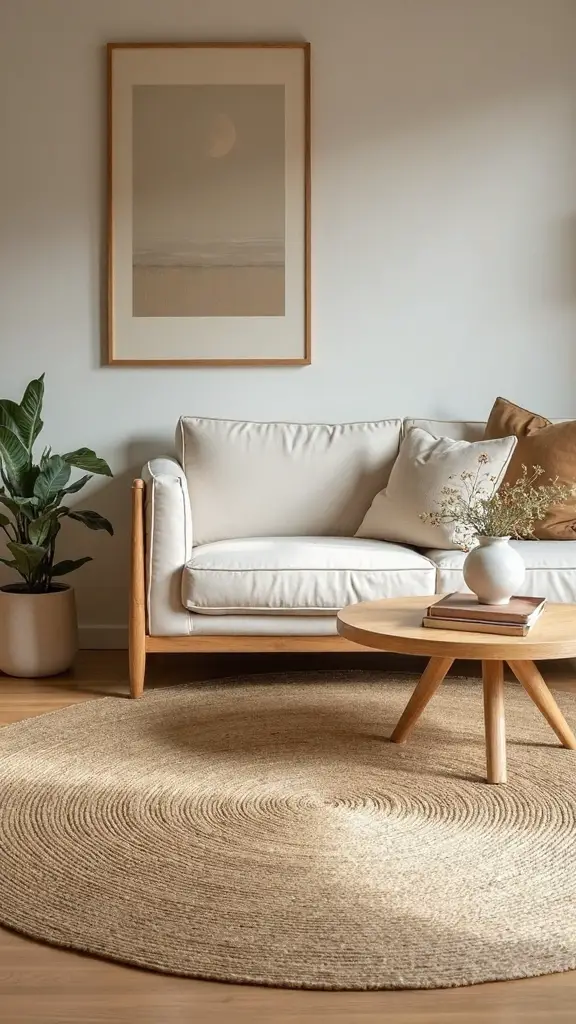
Layered textiles convert your Japandi living room from stark minimalism into a warm, inviting sanctuary that maintains the style’s signature clean aesthetic. Start by layering a jute rug beneath a plush, neutral-toned area rug for visual interest and comfort underfoot.
Add soft throw pillows and blankets crafted from natural linen or wool fibers to create cozy ambiance. Install sheer curtains that gently diffuse natural light while complementing your muted color palette.
Place woven baskets or rattan trays on your coffee table for functional storage with organic texture. Complete the look with macrame wall hangings that add dimensional depth.
Create Visual Interest With Wooden Accent Walls
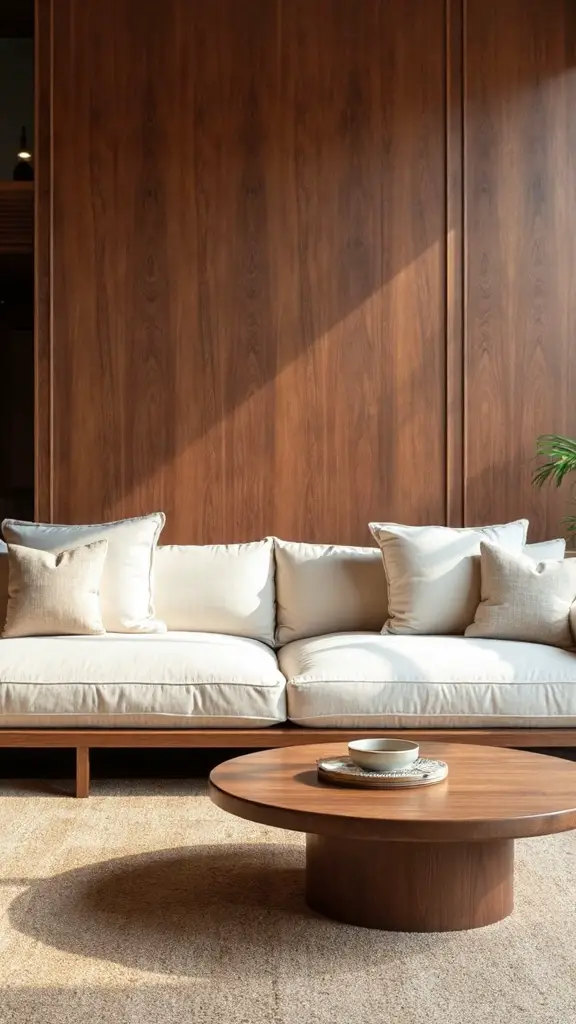
While maintaining your apartment’s serene Japandi atmosphere, wooden accent walls introduce natural warmth that alters blank surfaces into stunning focal points. Choose contrasting wood tones against your neutral walls to create visual interest without disrupting minimalism principles.
Install vertical slats or horizontal panels using different wood grains to add textural depth. Light oak against charcoal walls or rich walnut behind cream furniture anchors your space beautifully.
Complement your wooden feature wall with natural materials like rattan baskets or ceramic vases. This layered approach connects your Japandi living room to nature while preserving the clean, uncluttered aesthetic essential to this timeless design philosophy.
Select Multipurpose Coffee Tables for Small Spaces
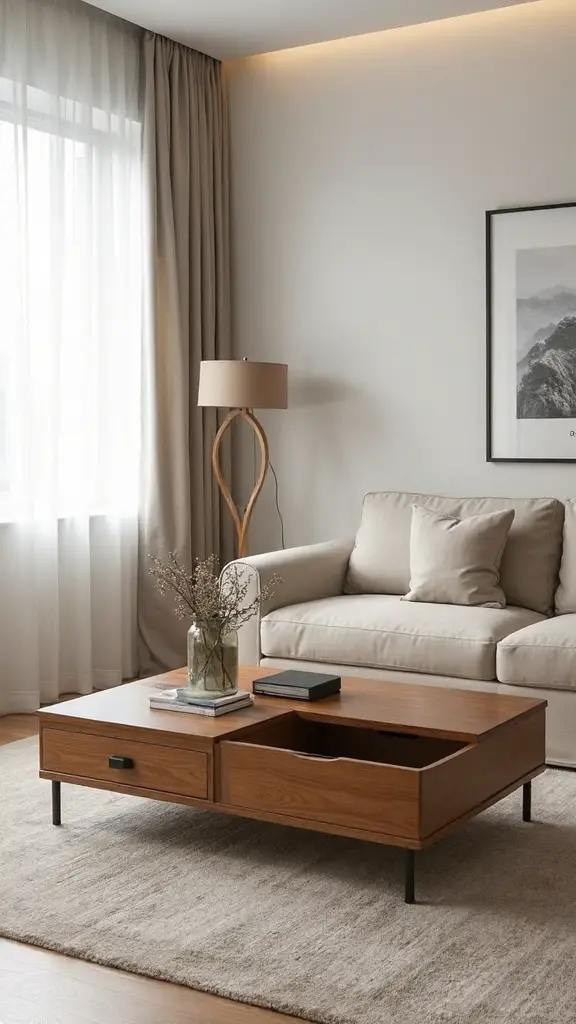
Small Japandi apartments demand every piece of furniture to earn its place through both beauty and function. Coffee tables with hidden storage maximize your modern living room’s potential by concealing remotes, magazines, and everyday clutter while maintaining Japandi design principles.
Choose round or oval wooden coffee tables to create seamless flow in tight spaces, avoiding sharp corners that disrupt movement. Glass-top options visually expand your living room design while preserving the minimalist aesthetic central to Japandi style.
Consider nesting or modular designs that adapt to your needs—separate them for entertaining or stack them to save precious floor space in your Japandi interior design.
Incorporate Ceramic and Stone Decorative Elements
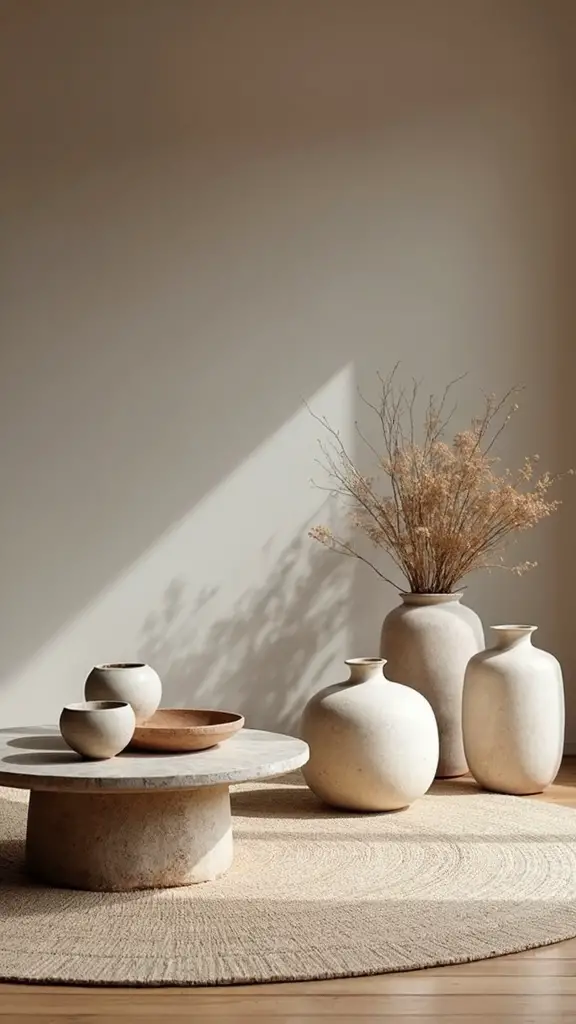
Natural ceramic and stone elements bring authentic texture to your Japandi apartment while honoring both Japanese wabi-sabi philosophy and Scandinavian craftsmanship traditions. Choose ceramic vases, bowls, and sculptural pieces in muted colors like beige, taupe, or sage green to complement your neutral palette. These earthy tones add organic warmth without overwhelming your minimalist space.
Incorporate stone tabletop decor such as marble accessories or granite elements to create lasting focal points. Handcrafted ceramic planters showcase your indoor greenery while connecting your room to nature. Consider sculptural stone objects like pebble-inspired centerpieces that serve as conversation starters while maintaining clean, uncluttered aesthetics.
Design a Cozy Reading Nook With Floor Cushions
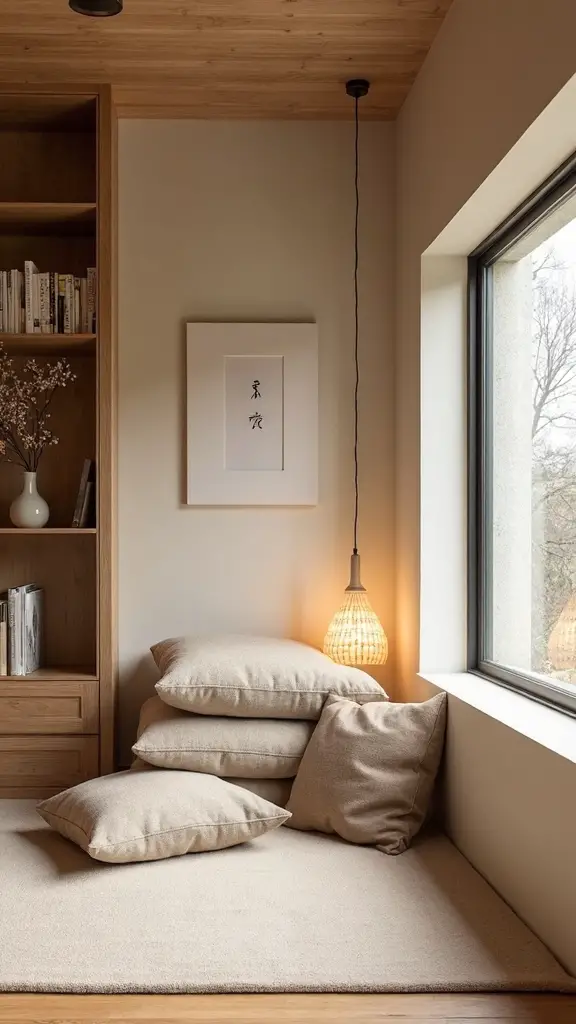
How can you alter an unused corner into the perfect retreat for quiet moments and literary escapes? Metamorphose your living room space by arranging comfortable floor cushions or a low-profile sofa in a quiet corner.
Choose soft, neutral-toned textiles like linen or velvet to create an inviting atmosphere that perfectly complements Japandi style. Position a small side table nearby to hold essential items like books and magazines.
Install a minimalist wall sconce or pendant light above to provide gentle, ambient light for your cozy reading nook. Surround the area with potted plants to enhance the serene interior environment.
Use Negative Space as a Design Element
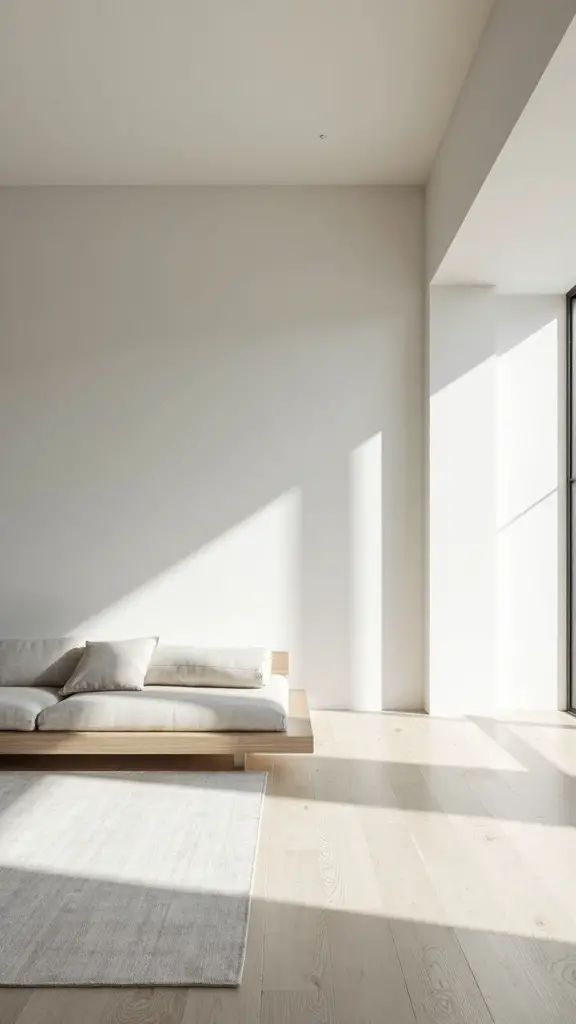
Everything between your furniture pieces serves a purpose in Japandi design, where negative space becomes just as important as the objects themselves. You’ll create an open, airy atmosphere by strategically placing furniture with generous gaps between each piece. This uncluttered approach allows your eye to rest while highlighting key design elements like artwork or structural features.
Leave substantial breathing room around your sofa, coffee table, and shelving units to establish calming visual balance. The resulting functionality extends beyond aesthetics—you’ll actually perceive your apartment as more spacious, even in compact urban settings where every square foot matters.
Create Contrast With Dark and Light Material Combinations
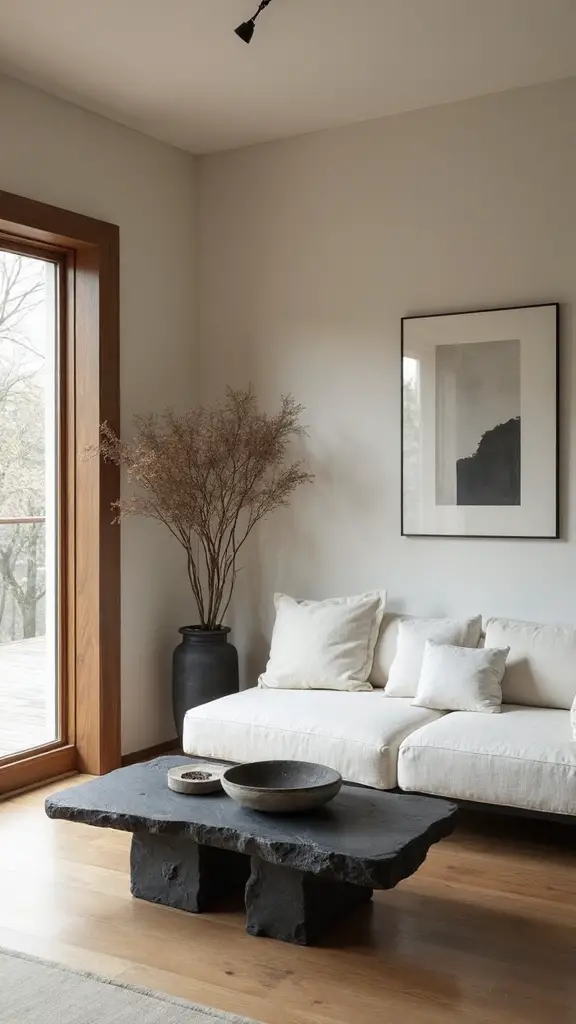
While thoughtful spacing sets the foundation for your Japandi aesthetic, strategic color pairings between dark and light materials will bring depth and visual interest to your living room.
This blend of Japanese minimalism thrives on a muted color palette where tones are often used to create balance. Pair charcoal gray furniture often with light walls and floors for striking contrast and visual appeal.
Add a glossy black coffee table against natural wood’s matte finish. Ground your space with pale rugs that offset darker accents, while bronze fixtures complement lighter oak pieces beautifully.
Add Subtle Pattern Through Natural Fiber Accessories
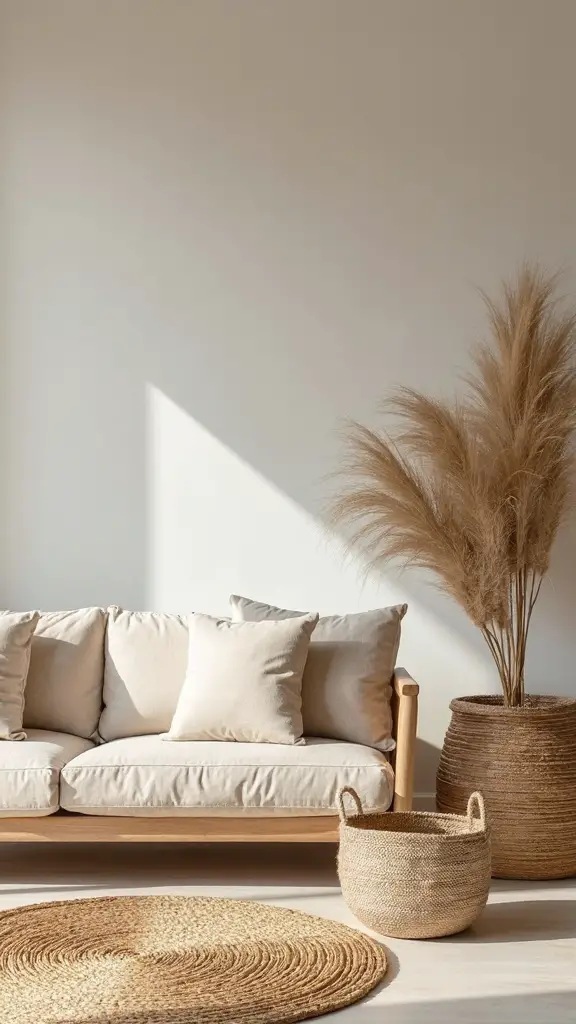
Natural fiber accessories offer the perfect opportunity to introduce subtle patterns that enhance your Japandi living room without disrupting its serene atmosphere. Incorporate woven baskets and textured throw pillows to add natural fiber patterns while maintaining visual balance. Layer jute rugs beneath your seating area for grounding texture that complements minimalist aesthetics.
Use patterned textiles sparingly—select striped or herringbone throws in muted, earthy tones that seamlessly blend with your color palette. Choose handcrafted rattan or bamboo décor pieces for organic touches. Complete the look with abstract nature-inspired artwork made from natural materials, creating sophisticated layers without overwhelming your peaceful space.
Design a Clutter-Free Entertainment Area
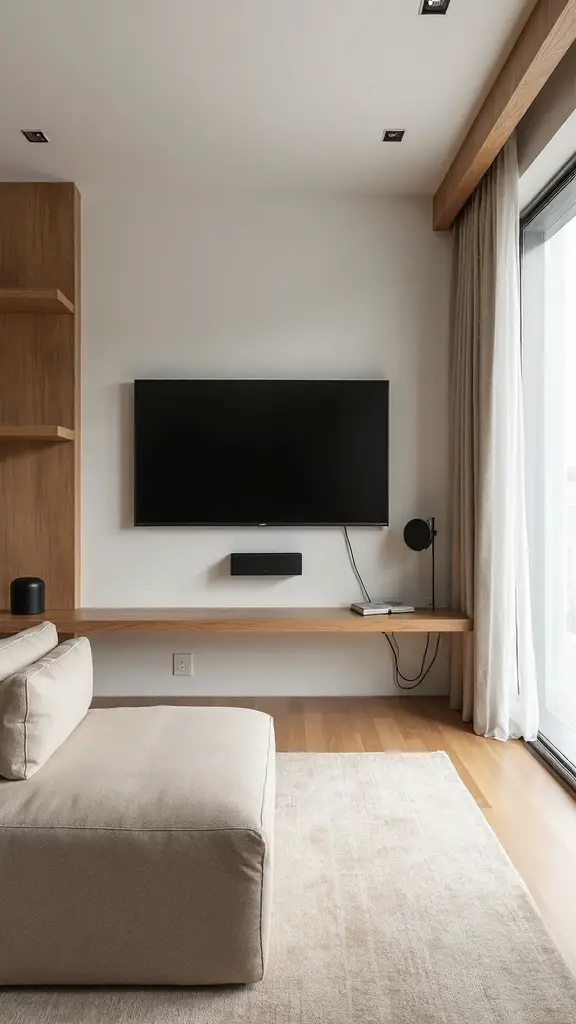
Creating a clutter-free entertainment area requires strategic planning that prioritizes both functionality and the peaceful aesthetics central to Japandi design. You’ll want to select a minimalist TV console featuring clean lines and hidden storage compartments that conceal media components completely. This approach maintains the simple, uncluttered foundation essential to both Japanese design and Scandinavian style principles.
Choose natural materials like light oak or bamboo for your entertainment furniture to align with Japandi’s organic aesthetic. The key to successful living room design lies in embracing minimalism—every element should serve a purpose while contributing to your space’s serene, organized atmosphere.
Conclusion
You’ve now got everything you need to convert your apartment into a serene Japandi sanctuary that perfectly balances function and beauty. Start with one or two elements that speak to you most, whether it’s decluttering your space or adding natural wood accents. Remember, authentic Japandi design develops gradually through thoughtful choices rather than quick makeovers. Take your time, trust the process, and you’ll create a minimalist haven that truly reflects this timeless aesthetic.
